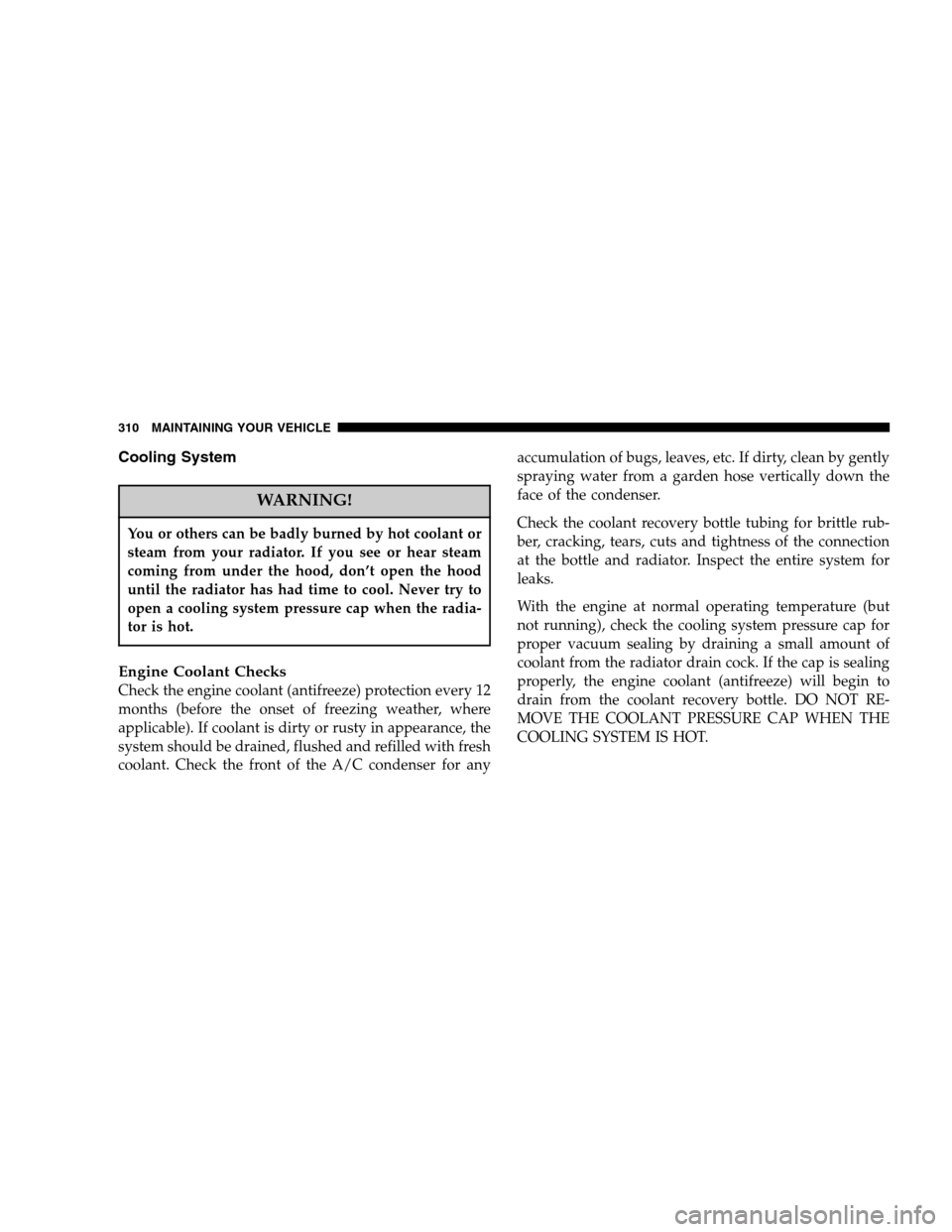Page 27 of 400

unlocked, you have 60 seconds to enter the vehicle, insert
the key in the Ignition and move it to the RUN position,
otherwise the engine will cancel remote start and auto-
matically turn off.
Remote start will also cancel if any of the following occur:
•If the engine stalls or RPM exceeds 2500
•Any engine warning lamps come on
•The hood is opened
•The hazard switch is pressed
•The transmission is moved out of park
•The brake pedal is pressed.
The vehicle can be started remotely up to a maximum of
two times. The vehicle is also allowed a maximum of one
failed start, where the remote start sequence was initiated
but cancelled before the engine begins to crank. Aftereither of these conditions, or if the Vehicle Theft Alarm is
alarming, or if the PANIC button was pressed, the vehicle
must be reset by inserting a valid key into the ignition
and moving it to the RUN position, then back to LOCK.
The parking lamps will remain illuminated to indicate
that the vehicle has remote started and the engine is
running. The lamps will turn off when the ignition is
turned to RUN or the remote start is cancelled.
DOOR LOCKS
Manual Door Locks
All the doors can be “manually” locked from the inside
by pushing down the door lock plunger, located on the
door trim panel. Both front doors may be opened from
the inside with the door lock plunger in the down or
locked position.
THINGS TO KNOW BEFORE STARTING YOUR VEHICLE 27
2
Page 76 of 400

�To Open And Close The Hood..............88
�Lights................................90
▫Interior Lights........................90
▫Battery Saver.........................91
▫Headlamp Delay.......................92
▫Headlights, Parking Lights, Panel Lights......92
▫Daytime Running Lights (Canada Only)......93
▫Lights-On Reminder....................93
▫Fog Lights — If Equipped................93
▫Cargo Light — If Equipped...............94
▫Multifunction Control Lever...............94
�Windshield Wipers And Washers.............96
▫Windshield Wipers.....................96▫Windshield Washers....................97
�Tilt Steering Column.....................98
�Electronic Speed Control — If Equipped.......99
▫ToActivate ...........................99
▫To Set At A Desired Speed...............100
▫To Deactivate........................100
▫To Resume Speed.....................100
▫To Vary The Speed Setting...............100
▫To Accelerate For Passing...............102
�Overhead Console......................103
▫Courtesy/Reading Lights................103
�Compass/Temperature Mini-Trip Computer....104
▫US/M Button........................104
76 UNDERSTANDING THE FEATURES OF YOUR VEHICLE
Page 88 of 400
heat level. Flashing indicator lights on the switch indicate
that the Heated Seat system needs servicing.
WARNING!
Persons who are unable to feel pain to the skin
because of advanced age, chronic illness, diabetes,
spinal cord injury, medication, alcohol use, exhaus-
tion or other physical condition must exercise care
when using the seat heater. It may cause burns even
at low temperatures, especially if used for long
periods of time.
Do not place anything on the seat that insulates
against heat, such as a blanket or cushion. This may
cause the seat heater to overheat.
TO OPEN AND CLOSE THE HOOD
To open the hood, two latches must be released. First pull
the hood release lever located under the left side of the
instrument panel.
Hood Release Lever Location
88 UNDERSTANDING THE FEATURES OF YOUR VEHICLE
Page 89 of 400
Then push the safety latch lever down while lifting the
grille with your right hand. It is located at the top center
of the grille just left of center.
Lift the hood and gas filled props will hold it open.To prevent possible damage, do not slam the hood to
close it. Use a firm downward push at the center front
edge of the hood to ensure that both latches engage.
Never drive your vehicle unless the hood is fully closed,
with both latches engaged.
WARNING!
If the hood is not fully latched, it could fly up when
the vehicle is moving and block your forward vision.
Be sure all hood latches are fully latched before
driving.
Secondary Latch Location (Push Down)
UNDERSTANDING THE FEATURES OF YOUR VEHICLE 89
3
Page 178 of 400

Temperature Control
The rotary knob at the center
of the control panel controls
the temperature of the inte-
rior air. You can choose your
degree of comfort by rotating
the knob. The coldest tem-
perature setting is to the ex-
treme left (blue region) and
the warmest setting is to the
extreme right (red region) of
the rotation.
Circulation
The cab is designed with features to promote outside air
circulation. There are grilles in the cab back panel. These
are air exhausters that provide the means for regular
exchange of cab air.Side window demisters direct air flow specifically to the
window glass to help prevent interior fogging of the
glass. They are located in the extreme outside upper
edges of the instrument panel. The demisters also pro-
vide extra air ducts for circulation. They are in operation
whenever the Floor, Mix, Defrost, or Bi-Level modes are
in use.
NOTE:When you turn off the engine you may hear a
hissing sound from under the hood for a short period of
time. This is a normal condition that occurs if the air
conditioning system has been on. It is not an indication of
a problem with the air conditioning system.Operating Tips
Fast Cooldown
For a fast cooldown, open the windows and turn the
blower fan rotary knob to the extreme right position, turn
the mode control to the panel fresh position, press the
snowflake button to turn on the air conditioning, and
178 INSTRUMENT PANEL AND CONTROLS
Page 310 of 400

Cooling System
WARNING!
You or others can be badly burned by hot coolant or
steam from your radiator. If you see or hear steam
coming from under the hood, don’t open the hood
until the radiator has had time to cool. Never try to
open a cooling system pressure cap when the radia-
tor is hot.
Engine Coolant Checks
Check the engine coolant (antifreeze) protection every 12
months (before the onset of freezing weather, where
applicable). If coolant is dirty or rusty in appearance, the
system should be drained, flushed and refilled with fresh
coolant. Check the front of the A/C condenser for anyaccumulation of bugs, leaves, etc. If dirty, clean by gently
spraying water from a garden hose vertically down the
face of the condenser.
Check the coolant recovery bottle tubing for brittle rub-
ber, cracking, tears, cuts and tightness of the connection
at the bottle and radiator. Inspect the entire system for
leaks.
With the engine at normal operating temperature (but
not running), check the cooling system pressure cap for
proper vacuum sealing by draining a small amount of
coolant from the radiator drain cock. If the cap is sealing
properly, the engine coolant (antifreeze) will begin to
drain from the coolant recovery bottle. DO NOT RE-
MOVE THE COOLANT PRESSURE CAP WHEN THE
COOLING SYSTEM IS HOT.
310 MAINTAINING YOUR VEHICLE
Page 334 of 400
1. Open the hood.
2. Remove the 3 screws attaching the headlamp housing
to the inner panel.
3. Grasp the headlamp and pull firmly to disengage the
headlamp housing from the fender panel.4. While firmly holding the headlamp housing in your
hands unlock and disconnect Headlamp bulb connector.
5. Twist 1/4 turn and remove headlamp bulb and socket
from housing and replace.
Removing Headlamp Assembly
Removing Headlamp Bulb
334 MAINTAINING YOUR VEHICLE
Page 337 of 400
Front Park and Turn Signal Lamp.
•
Open the hood.
•Remove the (3 ) screws attaching the headlamp hous-
ing to the inner panel.
•Grasp the headlamp and pull firmly to disengage the
headlamp housing from the fender panel.
NOTE:It is not necessary to disconnect the connector to
replace this bulb. If the bulb socket needs replacement
disconnect the connector.
Removing Turn Signal Bulb
MAINTAINING YOUR VEHICLE 337
7